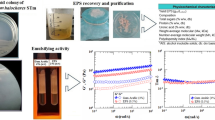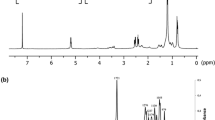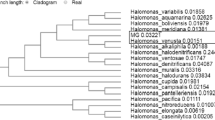Abstract
Halophilic microorganisms are producers of a lot of new compounds whose properties suggest promising perspectives for their biotechnological exploration. Moderate halophilic bacterium Chromohalobacter canadensis 28 was isolated from Pomorie salterns as an extracellular polymer substance (EP) producer. The best carbon source for extracellular polymer production was found to be lactose, a sugar received as a by-product from the dairy industry. After optimization of the culture medium and physicochemical conditions for cultivation, polymer biosynthesis increased more than 2-fold. The highest level of extracellular polymer synthesis by C. canadensis 28 was observed in an unusually high NaCl concentration (15% w/v). Chemical analysis of the purified polymer revealed the presence of an exopolysaccharide (EPS) fraction (14.3% w/w) and protein fraction (72% w/w). HPLC analysis of the protein fraction showed the main presence of polyglutamic acid (PGA) (75.7% w/w). EPS fraction analysis revealed the following sugar composition (% w/w): glucosamine 36.7, glucose 32.3, rhamnose 25.4, xylose 1.7, and not identified sugar 3.9. The hydrogel formed by PGA and EPS fractions showed high swelling behavior, very good emulsifying and stabilizing properties, and good foaming ability. This is the first report for halophilic bacterium able to synthesize a polymer containing PGA fraction. The synthesized biopolymer shows an extremely high hydrophilicity, due to the simultaneous presence of PGA and EPS. The analysis of its functional properties and the presence of glucosamine in the highest proportion in EPS fraction clearly determine the potential of EP synthesized by C. canadensis 28 for application in the cosmetics industry.






Similar content being viewed by others
References
Altschul SF, Gish W, Miller W, Myers EW, Lipman DJ (1990) Basic local alignment search tool. J Mol Biol 215:3389–3402. https://doi.org/10.1016/S0022-2836(05)80360-2
Arahal DR, Garcia MT, Ludwig W, Schleifer KH, Ventosa A (2001) Transfer of Halomonas canadensis and Halomonas israelensis to the genus Chromohalobacter as Chromohalobacter canadensis comb. nov. and Chromohalobacter israelensis comb. nov. Int J Syst Evol Microbiol 51:1443–1448. https://doi.org/10.1099/00207713-51-4-1443
Arias S, Del Moral A, Ferrer MR, Tallon R, Quesada E, Bejar V (2003) Mauran, an exopolysaccharides produced by the halophilic bacterium Halomonas maura, with a novel composition and interesting properties for biotechnology. Extremophiles 7:319–326. https://doi.org/10.1007/s00792-003-0325-8
Bajaj I, Singhal R (2011) Poly (glutamic acid)—an emerging biopolymer of commercial interest. Bioresour Technol 102:5551–5561. https://doi.org/10.1016/j.biortech.2011.02.047
Bakó J, Kerényi F, Hrubi E, Varga I, Daróczi L, Dienes B, Csernoch L, Gáll J, Hegedűs C (2016) Poly-γ-glutamic acid nanoparticles based visible light-curable hydrogel for biomedical application. J Nanomater 2016:Article ID 7350516. doi: https://doi.org/10.1155/2016/7350516
Béjar V, Llamas I, Calvo C, Quesada E (1998) Characterization of exopolysaccharides produced by 19 halophilic strains of the species Halomonas eurihalina. J Biotechnol 61:135–141. https://doi.org/10.1016/S0168-1656(98)00024-8
Bissett DL (2006) Glucosamine: an ingredient with skin and other benefits. J Cosmet Dermatol 5:309–315. https://doi.org/10.1111/j.1473-2165.2006.00277.x
Biswas J, Paul AK (2014) Production of extracellular polymeric substances by halophilic bacteria of solar salterns. Chin J Biol 2014:Article ID 205731. doi: https://doi.org/10.1155/2014/205731
Byong-Do K, Fos PA, Rha C (1987) Rheological characterization of high viscosity polysaccharides. In: Yalpani M (ed) Industrial polysaccharides: genetic, engineering, structure/propertis relations and applications. Elsivier, Amsterdam, pp 253–266
Cambon-Bonavita MA, Raguenes G, Jean J, Vincent P, Guézennec J (2002) A novel polymer produced by a bacterium isolated from a deep-sea hydrothermal vent polychaete annelid. J Appl Microbiol 93:310–315. https://doi.org/10.1046/j.1365-2672.2002.01689
Chan WP, Kung FC, Kuo YL, Yang MC, Lai WFT (2015) Alginate/poly (γ-glutamic acid) base biocompatible gel for bone tissue engineering. BioMed Res Int 2015:Article ID 185841. doi: https://doi.org/10.1155/2015/185841
Cojoc R, Merciu S, Oancea P, Pincu E, Dumitru L, Enache M (2009) Highly thermostable exopolysaccharide produced by the moderately halophilic bacterium isolated from a man-made young salt lake in Romania. Pol J Microbiol 58:289–294
Dubois M, Gilles KA, Hamilton JK, Rebers PA, Smith F (1956) Colorimetric method for determination of sugars and related substances. Anal Chem 28:350–356. https://doi.org/10.1021/ac60111a017
Figura LO, Teixeira AA (2007a) Interfacial phenomena. In: Food physics. Physical properties—measurement and applications. Springer, Berlin, pp 207–231. https://doi.org/10.1007/b107120
Figura LO, Teixeira AA (2007b) NonNewtonian flow behavior. In: Food physics. Physical properties—measurement and applications. Springer, Berlin, pp 148–150. https://doi.org/10.1007/b107120
Finore I, Orlando P, Di Donato P, Leone L, Nicolaus B, Poli A (2016a) Nesterenkonia aurantiaca sp. nov., an alkaliphilic actinobacterium isolated from Antarctica. Int J Syst Evol Microbiol 66:1554–1560. https://doi.org/10.1099/ijsem.0.000917
Finore I, Poli A, Di Donato P, Lama L, Trincone T, Fagnano M, Mori M, Nicolaus B, Tramice A (2016b) The hemicellulose extract from Cynara cardunculus: a source of value-added biomolecules produced by xylanolytic thermozymes. Green Chem 18:2460–2472. https://doi.org/10.1039/c5gc02774h
Garti N, Leser ME (2001) Emulsification properties of hydrocolloids. Polym Adv Technol 12:123–135. https://doi.org/10.1002/1099-1581(200101/02)12:1/2<123::AID-PAT105>3.0.CO;2-0
González-García Y, Heredia A, Meza-Contreras JC, Escalante FME, Camacho-Ruiz RM, Córdova J (2015) Biosynthesis of extracellular polymeric substances by the marine bacterium Saccharophagus degradans under different nutritional conditions. Int J Polym Sci 2015. https://doi.org/10.1155/2015/526819
Hezayen FF, Rehm BH, Tindall BJ, Steinbüchel A (2001) Transfer of Natrialba asiatica B1T to Natrialba taiwanensis sp. nov. and description of Natrialba aegyptiaca sp. nov., a novel extremely halophilic, aerobic, non-pigmented member of the Archaea from Egypt that produces extracellular poly (glutamic acid). Int J Syst Evol Microbiol 51:1133–1142. https://doi.org/10.1099/00207713-51-3-1133
Huval JH, Latta R, Wallace R, Kushner DJ, Vreeland RH (1995) Description of two new species of Halomonas: Halomonas israelensis sp. nov. and Halomonas canadensis sp. nov. Can J Microbiol 41:1124–1131. https://doi.org/10.1139/m95-156
Imeson A (2010) Food stabilisers, thickeners and gelling agents. Blackwell, Oxford, pp 6–10
Kambourova M, Mandeva R, Dimova D, Poli A, Nicolaus B, Tommonaro G (2009) Production and characterization of a microbial glucan, synthesized by Geobacillus tepidamans V264 isolated from Bulgarian hot spring. Carbohydr Polym 77:338–343. https://doi.org/10.1016/j.carbpol.2009.01.004
Ko YH, Gross RA (1998) Effects of glucose and glycerol on γ-poly(glutamic acid) formation by Bacillus licheniformis ATCC 9945a. Biotechnol Bioeng 57:430–437. https://doi.org/10.1186/s12934-017-0642-8
Lelchat F, Cozien J, Le Costaouec T, Brandilly C, Schmitt S, Baudoux AC, Colliec-Jouault S, Boisset C (2015) Exopolysaccharide biosynthesis and biodegradation by a marine hydrothermal Alteromonas sp. strain. Appl Microbiol Biotechnol 99:2637–2647. https://doi.org/10.1007/s00253-014-6075-y
Llamas I, Mata JA, Tallon R, Bressollier P, Urdaci MC, Quesada E, Béjar V (2010) Characterization of the exopolysaccharide produced by Salipiger mucosus A3T, a halophilic species belonging to the Alphaproteobacteria, isolated on the Spanish mediterranean seaboard. Mar Drugs 8:2240–2251. https://doi.org/10.3390/md8082240
Llamas I, Amjres H, Mata JA, Quesada E, Béjar V (2012) The potential biotechnological applications of the exopolysaccharide produced by the halophilic bacterium Halomonas almeriensis. Molecules 17:7103–7120. https://doi.org/10.3390/molecules17067103
Luo Z, Guo Y, Liu J, Qiu H, Zhao M, Zou W, Li S (2016) Microbial synthesis of poly-gamma-glutamic acid: current progress, challenges, and future perspectives. Biotechnol Biofuels 9:Article 134. doi: https://doi.org/10.1186/s13068-016-0537-7
Martínez-Cánovas MJ, Béjar V, Martínez-Checa F, Páez R, Quesada E (2004) Idiomarina fontislapidosi sp. nov. and Idiomarina ramblicola sp. nov. isolated from inland hypersaline habitats in Spain. Int J Syst Evol Microbiol 54:1793–1797. https://doi.org/10.1099/ijs.0.63172-0
Martínez-Checa F, Quesada E, Martínez-Cánovas J, Llamas I, Béjar V (2005) Palleronia marisminoris gen. nov., sp. nov., a moderately halophilic, exopolysaccharide-producing bacterium belonging to the ‘Alphaproteobacteria’, isolated from a saline soil. Int J Syst Evol Microbiol 55:2525–2530. https://doi.org/10.1099/ijs.0.63906-0
Mata JA, Béjar V, Llamas I, Arias S, Bressollier P, Tallon R, Urdaci MC, Quesada E (2006) Exopolysaccharides produced by the recently described halophilic bacteria Halomonas ventosae and Halomonas anticariensis. Res Microbiol 157:827–835. https://doi.org/10.1016/j.resmic.2006.06.004
Mata JA, Béjar V, Bressollier P, Tallon R, Urdaci MC, Quesada E, Llamas I (2008) Characterization of exopolysaccharides produced by three moderately halophilic bacteria belonging to the family Alteromonadaceae. J Appl Microbiol 105:521–528. https://doi.org/10.1111/j.1365-2672.2008.03789.x
Mehta A, Sidhu C, Pinnaka AK, Choudhury AR (2014) Extracellular polysaccharide production by a novel osmotolerant marine strain of Alteromonas macleodii and its application towards biomineralization of silver. PLoS One 9:e98798. https://doi.org/10.1371/journal.pone.0098798
Morris VJ (2006) Bacterial polysaccharides. In: Stephen AM, Phillips GO, Williams PA (eds) Food polysaccharides and their applications, Second edn. Taylor and Francis Group, Didcot, pp 413–454
Nicolaus B, Lama L, Manca MC, Gambacorta A (1999) Extremophiles: polysaccharides and enzymes degrading polysaccharides. Recent Res Dev Biotechnol Bioeng 2:37–64
Oren A (2010) Industrial and environmental applications of halophilic microorganisms. Environ Technol 31:825–834. https://doi.org/10.1080/09593330903370026
Osama HES, Kader AE, El Sayed M, Salem HM, Mahmoud MG, Asker MS, Saher MS (2015) Isolation, characterization and biological activities of exopolysaccharide produced by Bacillus marinus. Pharm Chem 7:200–208
Poli A, Esposito E, Orlando P, Lama L, Giordano A, de Appolonia F, Nicolaus B, Gambacorta A (2007) Halomonas alkaliantarctica sp. nov., isolated from saline lake Cape Russell in Antarctica, an alkalophilic moderately halophilic, exopolysaccharide-producing bacterium. Syst Appl Microbiol 30:31–38. https://doi.org/10.1016/j.syapm.2006.03.003
Poli A, Kazak H, Gürleyendağ B, Tommonaro G, Pieretti G, Öner ET, Nicolaus B (2009) High level synthesis of levan by a novel Halomonas species growing on defined media. Carbohydr Polym 78:651–657. https://doi.org/10.1016/j.carbpol.2009.05.031
Poli A, Di Donato P, Abbamondi GR, Nicolaus B (2011) Synthesis, production, and biotechnological applications of exopolysaccharides and polyhydroxyalkanoates by archaea. Archaea 2011:Article ID 693253. doi: https://doi.org/10.1155/2011/693253
Poli A, Nicolaus B, Denizci AA, Yavuzturk B, Kazan D (2013) Halomonas smyrnensis sp. nov., a moderately halophilic, exopolysaccharide-producing bacterium. Int J Syst Evol Microbiol 63:10–18. https://doi.org/10.1099/ijs.0.037036-0
Quesada E, Bejar V, Calvo C (1993) Exopolysaccharide production by Volcaniella eurihalina. Experientia 49:1037–1041. https://doi.org/10.1007/BF01929910
Radchenkova N, Vassilev S, Panchev I, Anzelmo G, Tomova I, Nicolaus B, Kuncheva M, Petrov K, Kamburova M (2013) Production and properties of two novel exopolysaccharides synthesized by thermophilic bacterium Aeribacillus pallidus 418. Appl Biochem 171:31–43. https://doi.org/10.1007/s12010-013-0348-2
Radchenkova N, Vassilev S, Martinov M, Kuncheva M et al (2014) Optimization of aeration and agitation speed on exopolysaccharide production by Aeribacillus palidus 418 and emulsifying properties of the product. Process Biochem 49:576–582
Radchenkova N, Panchev I, Vassilev S, Kuncheva M et al (2015) Continuous cultivation of a thermophilic bacterium Aeribacillus pallidus 418 for production of an exopolysaccharide applicable in cosmetic creams. J Appl Microbiol 119:1301–1309
Roca C, Lehmann M, Torres CA, Baptista S, Gaudêncio SP, Freitas F, Reis MA (2016) Exopolysaccharide production by a marine Pseudoalteromonas sp. strain isolated from Madeira Archipelago ocean sediments. New Biotechnol 33:460–466. https://doi.org/10.1016/j.nbt.2016.02.005
Sardari RR, Kulcinskaja E, Ron EY, Björnsdóttir S, Friðjónsson ÓH, Hreggviðsson GÓ, Karlsson EN (2017) Evaluation of the production of exopolysaccharides by two strains of the thermophilic bacterium Rhodothermus marinus. Carbohydr Polym 156:1–8. https://doi.org/10.1016/j.carbpol.2016.08.062
Smibert R, Krieg N (1981) General characteristics. In: Gerhardt P, Murray R, Costilow R, Nester E, Wood W, Phillips G (eds) Manual of methods for general bacteriology, vol 20006, third edn. American Society for Microbiology, Washington, pp 7–243
Sutherland IW (1987) Polysaccharide modification—a physiological approach. In: Yalpani M (ed) Industrial polysaccharides: genetic, engineering, structure/properties relations and applications. Elsevier, Amsterdam, pp 71–79
van Aken GA (2006) Polysaccharides in food emulsions. In: Stephen AM, Phillips GO, Williams PA (eds) Food polysaccharides and their applications, Second edn. Taylor and Francis Group, Didcot, pp 521–540
Walstra P (2003) Physical chemistry of foods. Marcel Dekker, New York, pp 397–436
Weisburg WG, Barns SM, Pelletier DA, Lane DJ (1991) 16S ribosomal DNA amplification for phylogenetic study. J Bacteriol 173:697–703. https://doi.org/10.1128/jb.173.2.697-703.1991
Yasar Yildiz S, Anzelmo G, Ozer T, Radchenkova N, Genc S, Di Donato P, Nicolaus B, Toksoy Oner E, Kambourova M (2014) Brevibacillus themoruber: a promising microbial cell factory for exopolysaccharide production. J Appl Microbiol 116:314–324. https://doi.org/10.1111/jam.12362
Yun UJ, Park D (2003) Physical properties of an extracellular polysaccharide produced by Bacillus sp. CP 912. Lett Appl Microbiol 36:282–287
Zeng W, Hu W, Li H, Jing Y, Kang H, Jiang Q, Zhang C (2014) Preparation and characterization of poly (γ-glutamic acid) hydrogels as potential tissue engineering scaffolds. Chinese J Polym Sci 32:1507–1514. https://doi.org/10.1007/s10118-014-1536-4
Zhang J, Dong YC, Fan LL, Jiao ZH, Chen QH (2015) Optimization of culture medium compositions for gellan gum production by a halobacterium Sphingomonas paucimobilis. Carbohydr Polym 115:694–700. https://doi.org/10.1016/j.carbpol.2014.09.029
Zheng C, Li Z, Su J, Zhang R, Liu C, Zhao M (2012) Characterization and emulsifying property of a novel bioemulsifier by Aeribacillus pallidus YM 1. J Appl Microbiol 113:44–51
Funding
This study was supported by the National Fund for Scientific Research, Bulgaria (Grant No. B02/26), and Joint Project session 2016–2018 of Bilateral Agreement between the Bulgarian Academy of Sciences (BAS), Bulgaria, and Consiglio Nazionale delle Ricerche (CNR), Italy.
Author information
Authors and Affiliations
Corresponding author
Ethics declarations
Conflict of interest
The authors declare that they have no conflict of interest.
Ethical statement
This article does not contain any studies with human participants or animals performed by any of the authors.
Electronic supplementary material
ESM 1
(PDF 321 kb)
Rights and permissions
About this article
Cite this article
Radchenkova, N., Boyadzhieva, I., Atanasova, N. et al. Extracellular polymer substance synthesized by a halophilic bacterium Chromohalobacter canadensis 28. Appl Microbiol Biotechnol 102, 4937–4949 (2018). https://doi.org/10.1007/s00253-018-8901-0
Received:
Revised:
Accepted:
Published:
Issue Date:
DOI: https://doi.org/10.1007/s00253-018-8901-0




